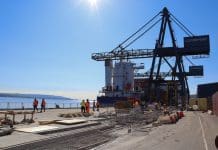The latest forecasts from the Construction Products Association suggest construction output will see growth each year, reaching 2.2 per cent growth in 2019
Forecasts for the next few years ahead suggest construction output will see growth. The Construction Products Association (CPA) said it expects the sector to increase by 0.8 per cent in 2017, 0.7 per cent in 2018, and 2.2 per cent in 2019.
Infrastructure activity in 2019 is expected to be the main driver of growth, with a 28.0 percent increase in this area and a 6.1 per cent increase in private house building. This, the CPA said, would make up for forecast declines in commercial and industrial construction.
CPA economics director Noble Francis said: “Near-term prospects for construction appear bright with industry growth boosted by several new billion pound infrastructure projects across the country such as the Thames Tideway Tunnel, HS2 and Hinkley Point C and the government’s £23 billion National Productivity Investment Fund.
“A rise in infrastructure output is expected to ensure positive growth for the construction industry overall if the government can ensure it delivers on its announcements.”
Positive outlook for housebuilding
Between 2017 and 2019, housebuilding is expected to be a key source of construction growth, with private building starts increasing by 2.0 per cent per year.
Francis said: “Construction industry prospects should also be boosted by a positive outlook from major house builders, who appear willing to increase supply as they take advantage of rising house prices in an undersupplied market.
“The exception to this is the high-profile niche of prime residential in central London, where there is already an oversupply of properties and sharply falling prices, which we expect to persist over the next 12-18 months.”
He continued: “Substantial risks to growth remain however as the fall in the value of Sterling is leading to increased import and raw materials costs.
“On the demand side, whilst the uncertainty post-Referendum has not impacted activity on site as yet, it appears to be affecting areas that require high upfront investment for a long-term rate of return such as commercial offices and industrial factories.
“Both have seen new contract awards fall and this is likely to feed through into falls in sector activity from the second half of this 2017.
“Despite these concerns, infrastructure and private housing are anticipated to ensure that the construction industry grows between 2017 and 2019, providing an extra £5.3 billion of economic activity for the construction industry and wider UK economy.”
Last week the CITB also suggested infrastructure projects would be a major source of growth in construction for the future.







![[VIDEO] World’s largest crane lifts final ring at Hinkley Point C Big Carl, the world's largest crane, lifting the final liner ring for Hinckley Point C](https://www.pbctoday.co.uk/news/wp-content/uploads/2024/10/94747-218x150.jpg)





